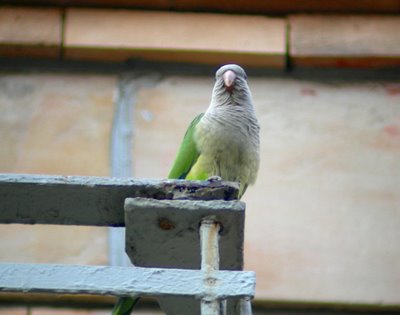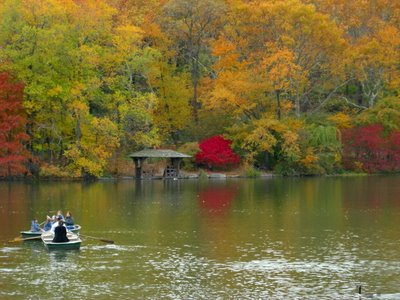
Photographs by Donegal Browne
Monk Parakeet, Myiopsitta monachus
Other common names in English include, Quaker Parrot or Parakeet, Gray-breasted Parrot, or Monk Parrot.
Peterson's, Birds of Eastern and Central North America, fifth edition, "Monk Parakeet, Myiopsitta monachus (Argentina) 11" (29 cm) Pale gray face and chest, buff band across belly. Has become established in spots from Conn. to Fla. and west to Ill. and Tex. Nest of sticks (only parrot to build a stick nest), massive with several compartments..."
In some states it's illegal to buy, breed, or own this species. In New York, it isn't illegal to own them but they must be banded and registered. As seeds and fruit are their diet staples, there was a concern that feral Monks might be a nuisance to farmers as they are considered to be in South America, but as they only seem to survive in the feral state where their main food sources are people provided, feeders and the like, some feel this concern is without merit.
There is also dispute about their impact on native bird populations. As to the air conditioner nest site, the non-native pigeons sometimes use these sites but after looking around, I don't see them using them in this particular neighborhood. Monk Parakeets are considered quite tough and in captivity are not kept in the same spaces with other species out of fear of their aggression.
(They sound like they're quite well adapted in the personality department for New York City.)
Manhattan Monk Parakeet Notes
Sunset-4:32PM (NYT)
Sunny
57F.

The nest, under an air conditioner on the sixth floor of an apartment building.
3:31PM No one is home. Some of the local residents stop by for a chat and are quite excited by the prospect of parakeet neighbors but are worried about their survival during winter or if someone moves the air conditioner. A few had noticed the birds nest building but some had not.

There are also twigs on the floor of the fire escape near by. One resident had seen Monks placing the twigs but it wasn't clear if it was the pair from the air conditioner nest or another pair all together. Monk Parakeets are able to survive in colder climes, unlike many other species of parrot, partially because of their snug nest homes. If their homes are tampered with in cold weather they often do not survive.



General plumage green; forehead bluish-grey; lores, cheeks and throat whitish-grey; breast brownish-grey, each feather edged with pale grey; upper abdomen olive-yellow; lower abdomen, rump, thighs and upper tail-coverts yellowish-green; outer webs of flight feathers blue; tail upperside green with blue down centre; underside pale green with greyish-blue base; periophthalmic ring grey; bill brownish-horn colour; iris dark brown; feet grey. Immatures with forehead tinged greenish.
 Though even more unclear in this web sized version of the photo, might that be the flash of a band worn on the leg doing the scratching?
Though even more unclear in this web sized version of the photo, might that be the flash of a band worn on the leg doing the scratching?
The difference in the sexes is slight and therefore DNA testing is often done to sex birds in captivity. (Of course there is always just waiting to see who lays eggs.)















